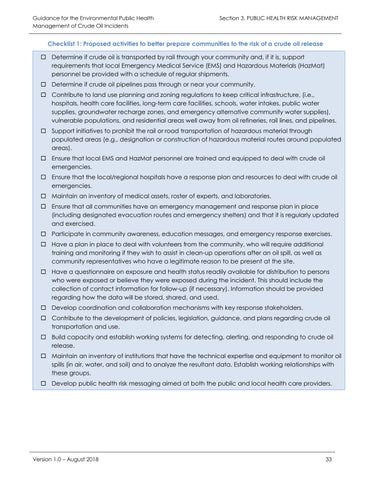Guidance for the Environmental Public Health Management of Crude Oil Incidents
Section 3. PUBLIC HEALTH RISK MANAGEMENT
Checklist 1: Proposed activities to better prepare communities to the risk of a crude oil release Determine if crude oil is transported by rail through your community and, if it is, support requirements that local Emergency Medical Service (EMS) and Hazardous Materials (HazMat) personnel be provided with a schedule of regular shipments. Determine if crude oil pipelines pass through or near your community. Contribute to land use planning and zoning regulations to keep critical infrastructure, (i.e., hospitals, health care facilities, long-term care facilities, schools, water intakes, public water supplies, groundwater recharge zones, and emergency alternative community water supplies), vulnerable populations, and residential areas well away from oil refineries, rail lines, and pipelines. Support initiatives to prohibit the rail or road transportation of hazardous material through populated areas (e.g., designation or construction of hazardous material routes around populated areas). Ensure that local EMS and HazMat personnel are trained and equipped to deal with crude oil emergencies. Ensure that the local/regional hospitals have a response plan and resources to deal with crude oil emergencies. Maintain an inventory of medical assets, roster of experts, and laboratories. Ensure that all communities have an emergency management and response plan in place (including designated evacuation routes and emergency shelters) and that it is regularly updated and exercised. Participate in community awareness, education messages, and emergency response exercises. Have a plan in place to deal with volunteers from the community, who will require additional training and monitoring if they wish to assist in clean-up operations after an oil spill, as well as community representatives who have a legitimate reason to be present at the site. Have a questionnaire on exposure and health status readily available for distribution to persons who were exposed or believe they were exposed during the incident. This should include the collection of contact information for follow-up (if necessary). Information should be provided regarding how the data will be stored, shared, and used. Develop coordination and collaboration mechanisms with key response stakeholders. Contribute to the development of policies, legislation, guidance, and plans regarding crude oil transportation and use. Build capacity and establish working systems for detecting, alerting, and responding to crude oil release. Maintain an inventory of institutions that have the technical expertise and equipment to monitor oil spills (in air, water, and soil) and to analyze the resultant data. Establish working relationships with these groups. Develop public health risk messaging aimed at both the public and local health care providers.
Version 1.0 – August 2018
33







